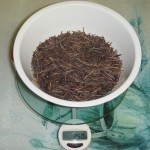by Cat, Nov 2007 (photo, right, from Wikimedia Commons)
Wild rice does not come from the same plant as traditional (Asian) rice, and is technically not a cereal grain. Wild rice was first cultivated by native peoples in North America, where it was grown in marshes of the northern great plains. It is rich in protein, high in B-complex vitamins, magnesium, potassium, phosphorus and zinc. It is relatively low in fat, so be sure to add plenty of butter.
It takes longer to cook than traditional rice, and also benefits from soaking in whey for at least 7 hours before cooking. I have learned to prefer this to regular rice, not only because it is not as contaminated with arsenic, but because I love the flavor, texture, and look of cooked wild rice. Plus, it is traditional to North America’s indigenous people.
I include two different recipes here; the second one (Long-Cooked) is my preference.
- Includes: 1. Steamed Wild Rice (Pre-Soaked), and 2. Steamed Wild Rice (Long-Cooked)
- See also: 1. Sides & Condiments Menu; 2. Steamed Brown Rice
Many people mix it with traditional rice when making pilaf. Whether or not the rices are presoaked, the wild rice should be cooked longer than the traditional rice with which it is to be mixed. If they are both cooked for the same length of time, it can cause digestive upset.
Wild Rice (Pre-Soaked)
This recipe, adapted from Nourishing Traditions, by Sally Fallon with Mary G. Enig (1), makes a lot of wild rice (serves 6 – 8). If you are not serving a large party, you can refrigerate or freeze the extra in glass containers for later use.
If you don’t have time to pre-soak, follow the cooking instructions in the Wild Rice (Long-Cooked) recipe, below.
Ingredients & Equipment:
- 2 cups wild rice seeds
- 4 cups warm filtered water plus 4 Tbsp whey or yogurt
- 1 tsp Unrefined sea salt
- 2 – 4 Tbsp butter
- Equipment:
- heavy 2 or 3 quart saucepan, or flameproof casserole
- steel simmer plate (if necessary)
Method:
- Place wild rice and warm water mixture in a heavy sauce pan or flameproof casserole; leave in a warm place for at least 7 hours.
- Bring to a boil, skim, and reduce heat to lowest possible setting. If your stove’s simmer is too hot, use a steel or cast iron simmer plate. Stir in salt and butter. Cover tightly and let steam for about 45 minutes, without removing lid.
- After 45 minutes, check the rice. If it is not tender, check water and add more if necessary, and steam a 7 – 10 minutes more; check doneness again. Repeat as necessary.
Steamed Wild Rice (Long-cooked)
(photo, right, from Wikimedia Commons )
This method is my favorite way to cook wild rice. It may take a bit longer but it is well worth it, and makes a lot of wild rice (8 – 10 generous servings).
I’ve adapted this version from the New Vegetarian Epicure by Anna Thomas (3). If you are not serving a large party, you can refrigerate or freeze the extra in glass containers such as Mason jars for later use, or see Ingredients for 2 servings, below. Or make a quarter or half recipe (¼ – ½ cup wild rice).
The original recipe by Anna Thomas is a pilaf made using roughly equal amounts of wild rice and brown rice, but I prefer just to use wild rice.
While it is not pre-soaked, it is cooked three times, which is nearly as good. And the cooking time isn’t really that long, about 55 minutes total.
I like the addition of mushrooms and cashews (see Wild Rice with Mushrooms and Cashews), but this is optional. Of course, you could pre-soak it, then start with step 3.
Ingredients & Equipment
for 8 – 10 servings:
- 2 cups wild rice seeds
- filtered water
- 1 tsp Unrefined sea salt, or to taste
- 2 Tbsp to ⅓ cup butter
- Equipment:
- heavy-bottomed 2 or 3 quart saucepan, saucier, or flameproof casserole
- steel simmer plate
for 2 servings
Cat’s note: I usually make “1 serving” (half of this recipe) for myself, which makes 4 servings for me, as I prefer a small serving with my dinners.
- ½ cup wild rice seeds
- filtered water
- ¼ tsp Unrefined sea salt
- ½ Tbsp butter
- Equipment:
- 1 ½-quart heavy-bottomed saucepan
- fine mesh strainer
- steel simmer plate
Method:
- Wash rice thoroughly and place in saucepan. Cover with cold, filtered water and bring to a boil over medium heat. Drain through mesh strainer.
- Repeat this procedure once more. Many of the seeds will have cracked open slightly.
- Cover with cold, filtered water a third time; bring to boil, then reduce heat to lowest possible setting (use simmer plate if necessary). Add salt, and steam for 45 minutes. Check for tenderness. All of the seeds should have cracked open fully, making a fluffy rice. Add more water if necessary if rice needs to cook longer.
- Stir in at least recommended amount of butter, and serve.
References:
- Nourishing Traditions, by Sally Fallon with Mary G. Enig (see Beloved Cookbooks for more about this book)
- Best of Friends, Etc., by Darlene Glantz Skees
- The New Vegetarian Epicure, by Anna Thomas (see Beloved Cookbooks for more about this book)


